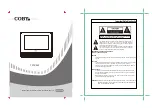
- 25 -
4000 4 319 _EN - 02/09
ENGLISH
3 - GENERAL VIEW
(see figure page 2)
3-1
CONTROLS
1
Level/Offset/Duty cycle display
18
Cursor to the left
2
Frequency Display
19
Frequency counter input
3
Modulation Display
20
External modulation input/sweep sync output
4
Function Display (sine/square, etc.)
21
TTL output
5
- 40 dB attenuation LED
22
50
Ω
output
6
- 20 dB attenuation LED
23
RS-232 socket
7
Offset decalibration LED
24
On/Off switch
8
Duty cycle decalibration LED
25
Mains fuse-holder
9
Function/frequency counter Selection
10
Frequency/4/10-digit display Selection
11
Level/Attenuation Selection
12
Offset/ Recall Selection
13
Duty cycle/Store Selection
14
Module ON/OFF Selection
15
Valid/Calibration Selection
16
Cursor to the right
17
Thumbwheel, selected value modification
4 - FRONT PANEL OVERVIEW
PUSh-BUTTONS
All push-buttons, except those used to move the cursor [
16
] and [
18
] have double action. The first press selects
the parameter indicated above the button. The second press selects that indicated below the button.
DISPLAY
The upper line of the display is dedicated to the parameters
Frequency
[2] and
Function
[4]. The lower line shows,
on the right, the current
Modulation
state [3] and, on the left, any selected parameter different from those already
displayed [1], such as
Level, Offset, etc
.
The cursor (a horizontal line below a character) points to the currently selected parameter. For all parameters, it is
possible to move the cursor to the digit to be modified using buttons [18] and [16]. In the
Frequency, Level and Rate
menus, it is possible to change the value in decades by positioning the cursor on the unit (
Hz, Vpp, S
).
THUMBWHEEL SWITCH
The thumbwheel switch [17] modifies the selected parameter, i.e. that below which the cursor is.
5 - DESCRIPTION OF BASIC COMMANDS
FUNCTION SELECTION
(Function)
When the generator is switched on, the cursor positions itself below the function. Rotate the thumbwheel switch [17]
to select the desired function:
Sin
(sine),
Squ
(square),
Tri
(triangle),
Rup
(ramp up),
Rdo
(ramp down),
DC
(direct
current). The signal at the
50
Ω
output [22] follows the selected function.
If the cursor is not below the function, a simple press of the
Function
button [9] selects it.
FREQUENCY ADJUSTMENT
(FREQ.)
Pressing the
Freq.
button [10] selects the frequency with a display in the standard mode (4 digits). A second press
of the same button changes the display to the extended mode (10 digits).
When the
Frequency
parameter is selected, the cursor moves to the left digit.
The frequency can be set to within a digit and to minimum resolution by the combined action of the thumbwheel [17]
and buttons
[18] and
[16].
Pressing one of these buttons moves the cursor to the digit to be modified.
When the cursor is on the least significant digit, pressing the
button moves it to the
H
of
Hz,
and the thumbwheel
switch can then be used to change the frequency in decades (
10Hz, 100Hz, 1KHz, ...
).
The cursor wraps around:
If the cursor is below the
H
of
Hz,
pressing the
button will move it to the most significant digit. Conversely, if the
cursor is on this digit, pressing the
button will move it back to the
H
of
Hz.
SIGNAL AMPLITUDE ADJUSTMENT
(LEVEL)
Fig. 7
The signal amplitude is adjusted using the thumbwheel switch and the
Level / Attenu.
button [11]. A first press of
this button selects the level, which can vary from 2.0 to 20.0 V (i.e. 20dB) in 0.1 V steps.
Summary of Contents for GF 266
Page 18: ...18 4000 4 319 02 09 FRANCAIS...
Page 34: ...34 4000 4 319 _EN 02 09 ENGLISH...
















































